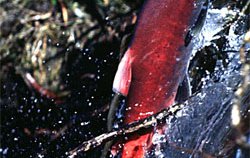Photo: Sockeye salmon jumping over beaver dam Lake Aleknagik, AK by Kristina Ramstad 1997.
The Alaska Department of Fish and Game has released the 2017 Alaska Fisheries Enhancement Report, which documents salmon hatchery production in the state.
In 2017, the commercial fleet caught about 47 million hatchery-produced salmon. This harvest was worth an estimated $331 million in first wholesale value and $162 million in ex vessel value.
Hatcheries contributed 21% of the 2017 statewide commercial salmon harvest, which is the lowest percentage of hatchery-produced fish in the harvest since 1995. The lower hatchery contribution was due to the strong wild stock return in 2017, which was the third highest wild stock commercial salmon harvest in Alaska history.
An additional 194,000 Alaska hatchery-produced fish were caught in the sport, personal use, and subsistence fisheries.
Hatchery production in Alaska is designed to supplement — not replace — wild stock production. In the past five years, Alaska's hatchery-produced salmon have returned alongside record returns of its wild stocks. Alaska's salmon harvests in 2013, 2015 and 2017 were three of the four highest wild stock returns in history dating back to the late 1800s. Alaska's statewide 2017 chum salmon harvest was the highest, and pink salmon harvest the fourth highest, on record. Record returns were recorded in several areas of the state where there is no hatchery production, as well. Norton Sound had a record return of coho salmon, and Chignik and the Alaska Peninsula had record returns of pink salmon. In Bristol Bay, the 2017 sockeye salmon harvest was the third highest since 1975, and the third consecutive year of strong harvests.
Abundance-based wild stock management priority, habitat protection, and record wild-stock harvests reflect the state's commitment to conservation of wild stocks and provide the foundation of its salmon hatchery program.












